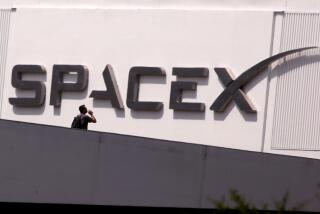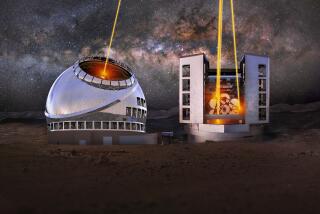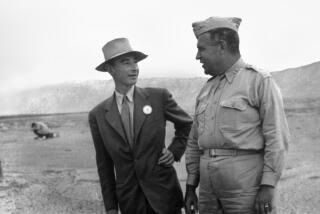Funding Fights Don’t Deter Building of Super Collider : Science: Debate over atom smasher’s cost goes on, but folks in Texas plow ahead with biggest physics tool ever.
- Share via
WAXAHACHIE, Tex. — Running the nation’s newest national laboratory keeps Roy Schwitters running. He shuttles daily between a Dallas industrial park devoted entirely to his project, the Superconducting Super Collider, and a warehouse here that is its headquarters.
He keeps on running because the warehouse--so big that workers have given street names to the aisles separating their cubicles to make it easier for them to find their desks--is miles from the construction sites, where massive tunneling machines gnaw 300 feet a day through the chalk and shale beneath the flat Texas prairie.
When a Russian physicist visits, offering some of his nation’s best technology in exchange for the opportunity to participate in the collider’s cutting-edge physics experiments, Schwitters is delighted--and amused.
“Can you imagine two people less likely to plan so far in advance?” asked Schwitters, the director of the Superconducting Super Collider laboratory. “Neither one of us knows if my lab--or his country--will even exist a year from now.”
Even as Congress prepares to divvy up the massive 1994 federal science budget--and, in the process, decide once more if it really wants a Superconducting Super Collider--folks in Texas are busily building history’s biggest and costliest scientific instrument.
Nothing about the effort indicates uncertainty: $2 billion has been spent, half a dozen structures have been built, 8,600 50-foot superconducting magnets have been ordered, more than three miles of tunnels have been bored and another 30 miles are under contract.
“The SSC is getting built,” said Schwitters, “whether people like it or not.”
Indeed it is. And indeed some don’t.
Balanced-budget lobbyists and a considerable cadre of elected officials are among those who do not like it. They argue that the collider--costs are projected at $8.2 billion now, rising to $10 billion if the White House succeeds in stretching out construction five more years--is an unaffordable luxury, and they are plotting to attack when its 1994 budget comes up for a House vote later this month.
Supporters contend that the collider--which will strive to unravel some of the greatest mysteries of physics by discovering nature’s smallest particles--will help the United States remain dominant in science. But they are not sure how much help they can rely on from putative allies in the Clinton Administration and in the scientific community when the collider is considered by a newly frugal Congress, particularly if the SSC is portrayed as siphoning too much money from other science projects.
Rep. George E. Brown Jr. (D-Colton), chairman of the House Science Committee, gives the SSC only a 50-50 chance of survival. And he is one of the bigger Super Collider enthusiasts.
“This campaign will be a tough one,” he said. “I am not at all sure we’ll make it.”
While Washington waffles, Waxahachie is rolling up its sleeves.
Each morning, hundreds of workers scatter to construction sites on the Ellis County prairie 35 miles south of Dallas. Some mount four locomotive-size tunneling machines--”inchworms” they call them--to chew through chalk and shale. Others produce collider parts or work on an exotic liquid-helium refrigeration system that will chill the 54-mile-long device to 450 degrees below zero Fahrenheit. Its powerful magnets work only at that temperature.
The one-story central office building alone sprawls over 500,000 square feet.
More offices and machine shops are located in Dallas, where the University Research Assn.--a consortium of 70 universities, including eight in California--oversees construction for the U.S. Department of Energy.
Meanwhile, contractors have built or refurbished their factories elsewhere in Texas and in Louisiana and Virginia; others at UC Berkeley and Caltech in Pasadena are beavering away on the collider’s two detectors, hotel-size instruments that will study the subatomic debris created when the SSC smashes protons head-on at nearly the speed of light.
If critics are chary about writing off this kind of investment, it doesn’t show.
“When another ($8 billion to complete construction) is at stake, killing the project still makes sense,” said Pete Sepp of the National Taxpayers’ Union in Washington.
SSC supporters have generated reams on the subject. And a few months ago, they dispatched a squad of overqualified salesmen--12 leading physicists, including five Nobel Prize winners--to Capitol Hill to try to close the deal.
The sales pitch is hampered because the benefits of the Super Collider, like those of other basic-science projects, are maddeningly difficult to predict. The goal is to discover nature’s basic rules, the scientists say, and to use that knowledge to better manipulate science.
Scientists know that everything is made of atoms and that atoms are made up of smaller particles called protons, neutrons and electrons. But even tiny protons and neutrons contain tinier bits of matter, called quarks. Other fantastically small particles--gluons, photons and bosons--hold all these parts together.
Physicists have seen most of these parts by smashing together protons and electrons, rather like dropping a radio from a skyscraper and analyzing the parts that come out. Some atom parts cling together furiously, so it takes increasingly powerful devices, such as the Super Collider, to break them free for study. Among the atom parts that scientists hope to discover and study with the SSC are the powerful Higgs boson and the very heavy “top” quark.
If all this seems esoteric, well, scientists concede that it is. But, they argue, that makes it no less important.
After all, quantum mechanics, with its curious wave-particle duality and uncertainty principle, seemed absurdly abstract when it was developed. But, scientists said, it explained important rules of nature and became the theoretical foundation of the computer and electronics industry. Quantum mechanics adds billions to the nation’s economy even though it is still unintelligible to nearly everyone.
Nobel Laureate Leon Lederman, as skillful a raconteur as he is a scientist, said physicists are like extraterrestrials watching a soccer game without seeing the ball. They can see order but not what is causing the fuss.
People in Waxahachie feel that same way every spring when the Super Collider budget debate blossoms anew. They see the orderly construction but not what’s causing the fuss over whether to continue building.
A few joke about what Congress can do with the tunnel if it pulls the plug on the collider: Turn it into a wine cellar, a mushroom farm, a nuclear waste dump or even a super guacamole maker. Others, polite but plain-spoken, just wish that Washington would make up its mind and stick to it.
“It’s stupid to keep debating,” said James R. Jenkins, a lawyer who has represented a few people whose property was purchased to make room for the Super Collider. “They ought to do it all the way or shut it down before they waste any more money on it.”






